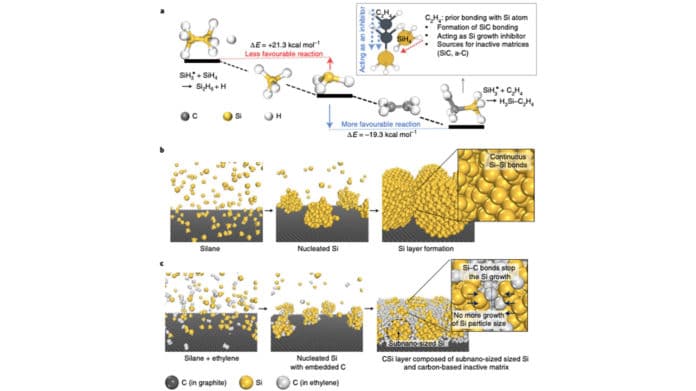A research team affiliated with UNIST has developed a new approach that improves the durability of silicon (Si)-based anode materials. This new anode material has a high capacity for future lithium-ion batteries (LIBs) with an extended life cycle.
Achieving higher energy density Li-ion batteries is possible by replacing existing anodes with high-capacity materials. Silicon is considered a promising candidate for its high capacity. However, this material suffers from severe structural degradation and instability of the solid–electrolyte interphase (SEI) caused by substantial volumetric fluctuations during (de)lithiation.
During cycling, the alloy-based anodes have a large volume variation. Hence, it is better to use small anode particles for an extended battery cycle life. However, it has been challenging to realize sub-nano-sized particles.
Scientists, in this study, come up with a growth inhibition mechanism that prevents continuous enlargement of size immediately after nucleation during chemical vapor deposition. When this mechanism was applied to the synthesis of silicon, it yielded sub-nano-sized particles.
Scientists noted, “Ethylene not only functions as a silicon growth inhibitor, thereby slowing the growth of nucleated silicon via Si–C bond formation, but also acts as a source to create the dual matrix. The sub-nano-sized silicon anode enhances the cycling stability (Coulombic efficiency reaching 99.96% over 50 cycles). Finally, the practical application of the fabricated energy storage system (103.2 kWh) containing 110 Ah full-cells with 91% capacity retention for 2,875 cycles and calendar life of 97.6% for one year is demonstrated.”
Distinguished Professor Jaephil Cho at UNIST said, “These results can provide inspiration for battery researchers to consider the parameters for high-capacity alloy anode design and can pave the way for next-generation anodes in high-energy lithium-ion battery systems for application in energy storage systems and electric vehicles.”
Journal Reference:
- Jaekyung Sung, Namhyung Kim, Jiyoung Ma, et al., “Subnano-sized silicon anode via crystal growth inhibition mechanism and its application in a prototype battery pack,” Nature Energy, (2021). DOI: 10.1038/s41560-021-00945-z
